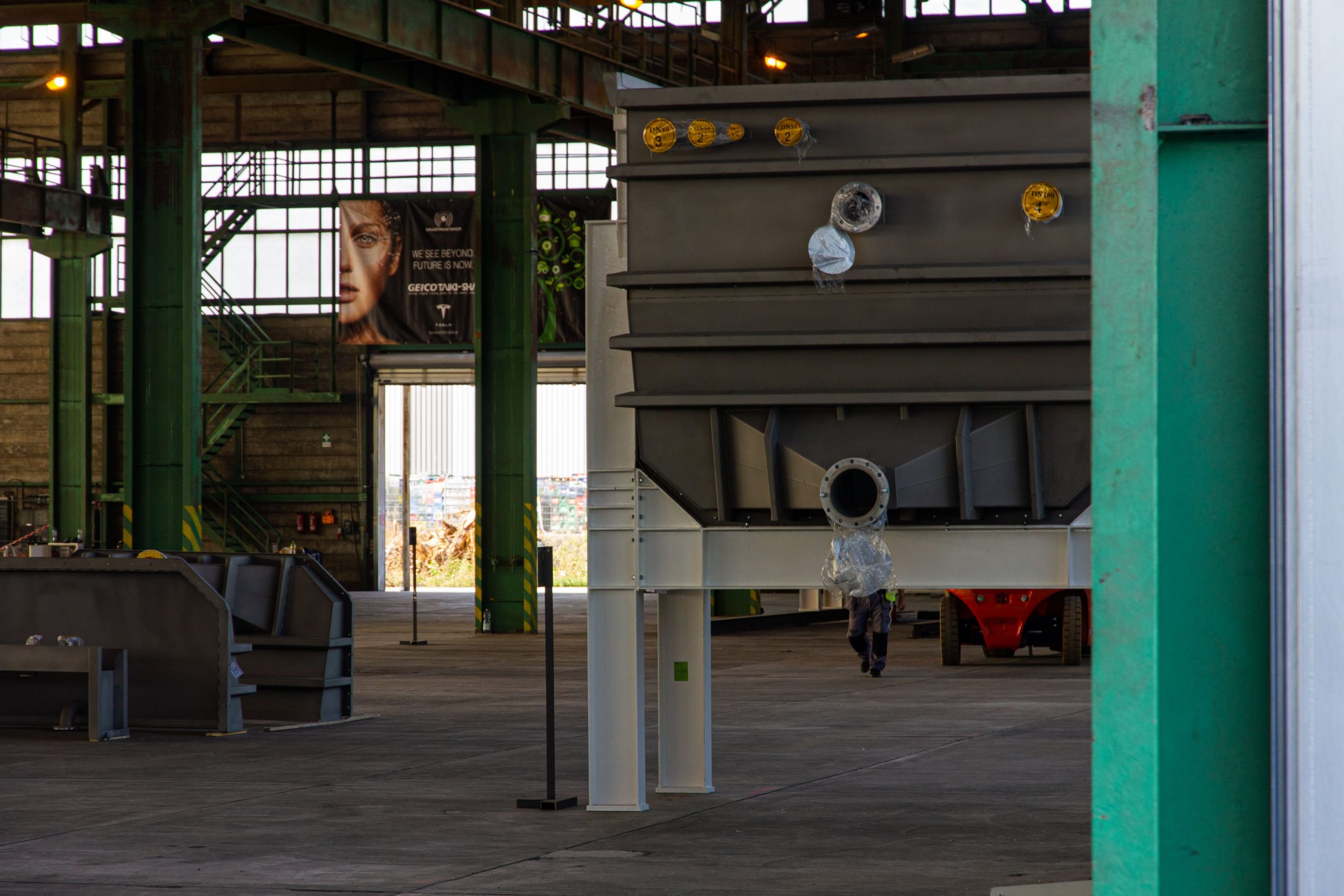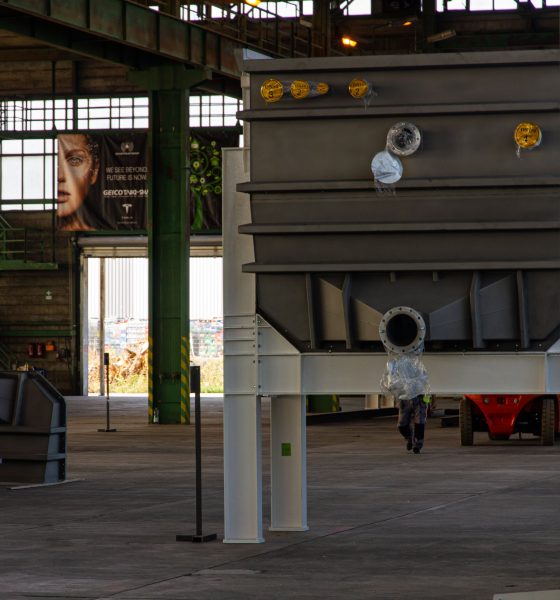

News
Tesla partners with automated paint shop company at Giga Berlin
Tesla has partnered with Geico Taikisha for Giga Berlin’s paint shop, and the first machines have arrived on site. Tesla plans to improve its paint quality at Giga Berlin dramatically, and the electric carmaker has recruited Geico Taikisha’s automated machines to help solve the lengthy issues that the company has had with its automotive coatings.
@gigafactory_4 spotted several large machines with Geico Taikisha labels on Twitter. The devices, which are fully automated for efficiency and quality reasons, will aim to revolutionize the way Tesla paints its vehicles at the European production plant.
The partnership was also confirmed by several advertisements that sit outside of the buildings where the paint machines are being stored. The banners dawn both Geico Taikisha and Tesla logos, indicating the two companies are working together for the automaker’s attempt to revamp its paint projects.
Looks like the first machines for #GigaBerlin already arrived! Never heard about Geico Taiki-Sha.
Seems to be an innovative italian coating company.https://t.co/MqpFwWkFMFAny additional information @tobilindh @Gf4Tesla?
Thanks @SimoneCatharin for the hint. pic.twitter.com/pcReYMhNRV
— Giga Berlin / Gigafactory 4 (@gigafactory_4) September 15, 2020
Tesla will likely use the company’s “Smart Paintshop,” based on the fact that the banner displays the logo for that solution.
The Smart Paintshop uses a series of computer-generated designs, along with 4D modeling, to create a high-quality paint application while reducing energy usage.
According to Geico Taikisha’s website, its paintshop solutions are fully customizable and are turnkey systems. The customization gives the client full range control over how the system will operate, and Tesla’s automation goals indicate that the paint shop will be operated by machinery with little human interaction.
Additionally, Geico Taikisha’s innovation-focused approach allows the company to increase the technological possibilities that its clients request continually. The customizable systems that give a broad range of options “in order to meet the needs of the most demanding customers in a highly competitive sector,” the company’s website states.
Geico Taikisha’s goals also line up with Tesla’s in terms of sustainability and energy efficiency. The company’s paintshop systems use 70% less energy consumption than competitors and are 30% powered by renewable resources.
The partnership will allow Tesla to increase the quality of its paintshop while also increasing automation.
The electric automaker has stressed that its main focus is to increase production and manufacturing efficiency through innovation. Still, another main focus was to improve the quality of its paint shop.
Elon Musk stated that Giga Berlin would have a world-class paint facility, offering new colors that would change with the curvature of the vehicles produced at the facility.
The partnership could lead to these developments, eventually becoming a reality. It is already known that Giga Berlin will offer a new Deep Crimson color, but the improvements to the paintshop have been relatively undisclosed until now.

News
Tesla FSD fleet is nearing 7 billion total miles, including 2.5 billion city miles
As can be seen on Tesla’s official FSD webpage, vehicles equipped with the system have now navigated over 6.99 billion miles.

Tesla’s Full Self-Driving (Supervised) fleet is closing in on almost 7 billion total miles driven, as per data posted by the company on its official FSD webpage.
These figures hint at the massive scale of data fueling Tesla’s rapid FSD improvements, which have been quite notable as of late.
FSD mileage milestones
As can be seen on Tesla’s official FSD webpage, vehicles equipped with the system have now navigated over 6.99 billion miles. Tesla owner and avid FSD tester Whole Mars Catalog also shared a screenshot indicating that from the nearly 7 billion miles traveled by the FSD fleet, more than 2.5 billion miles were driven inside cities.
City miles are particularly valuable for complex urban scenarios like unprotected turns, pedestrian interactions, and traffic lights. This is also the difference-maker for FSD, as only complex solutions, such as Waymo’s self-driving taxis, operate similarly on inner-city streets. And even then, incidents such as the San Francisco blackouts have proven challenging for sensor-rich vehicles like Waymos.
Tesla’s data edge
Tesla has a number of advantages in the autonomous vehicle sector, one of which is the size of its fleet and the number of vehicles training FSD on real-world roads. Tesla’s nearly 7 billion FSD miles then allow the company to roll out updates that make its vehicles behave like they are being driven by experienced drivers, even if they are operating on their own.
So notable are Tesla’s improvements to FSD that NVIDIA Director of Robotics Jim Fan, after experiencing FSD v14, noted that the system is the first AI that passes what he described as a “Physical Turing Test.”
“Despite knowing exactly how robot learning works, I still find it magical watching the steering wheel turn by itself. First it feels surreal, next it becomes routine. Then, like the smartphone, taking it away actively hurts. This is how humanity gets rewired and glued to god-like technologies,” Fan wrote in a post on X.
News
Tesla starts showing how FSD will change lives in Europe
Local officials tested the system on narrow country roads and were impressed by FSD’s smooth, human-like driving, with some calling the service a game-changer for everyday life in areas that are far from urban centers.

Tesla has launched Europe’s first public shuttle service using Full Self-Driving (Supervised) in the rural Eifelkreis Bitburg-Prüm region of Germany, demonstrating how the technology can restore independence and mobility for people who struggle with limited transport options.
Local officials tested the system on narrow country roads and were impressed by FSD’s smooth, human-like driving, with some calling the service a game-changer for everyday life in areas that are far from urban centers.
Officials see real impact on rural residents
Arzfeld Mayor Johannes Kuhl and District Administrator Andreas Kruppert personally tested the Tesla shuttle service. This allowed them to see just how well FSD navigated winding lanes and rural roads confidently. Kruppert said, “Autonomous driving sounds like science fiction to many, but we simply see here that it works totally well in rural regions too.” Kuhl, for his part, also noted that FSD “feels like a very experienced driver.”
The pilot complements the area’s “Citizen Bus” program, which provides on-demand rides for elderly residents who can no longer drive themselves. Tesla Europe shared a video of a demonstration of the service, highlighting how FSD gives people their freedom back, even in places where public transport is not as prevalent.
What the Ministry for Economic Affairs and Transport says
Rhineland-Palatinate’s Minister Daniela Schmitt supported the project, praising the collaboration that made this “first of its kind in Europe” possible. As per the ministry, the rural rollout for the service shows FSD’s potential beyond major cities, and it delivers tangible benefits like grocery runs, doctor visits, and social connections for isolated residents.
“Reliable and flexible mobility is especially vital in rural areas. With the launch of a shuttle service using self-driving vehicles (FSD supervised) by Tesla in the Eifelkreis Bitburg-Prüm, an innovative pilot project is now getting underway that complements local community bus services. It is the first project of its kind in Europe.
“The result is a real gain for rural mobility: greater accessibility, more flexibility and tangible benefits for everyday life. A strong signal for innovation, cooperation and future-oriented mobility beyond urban centers,” the ministry wrote in a LinkedIn post.
News
Tesla China quietly posts Robotaxi-related job listing
Tesla China is currently seeking a Low Voltage Electrical Engineer to work on circuit board design for the company’s autonomous vehicles.

Tesla has posted a new job listing in Shanghai explicitly tied to its Robotaxi program, fueling speculation that the company is preparing to launch its dedicated autonomous ride-hailing service in China.
As noted in the listing, Tesla China is currently seeking a Low Voltage Electrical Engineer to work on circuit board design for the company’s autonomous vehicles.
Robotaxi-specific role
The listing, which was shared on social media platform X by industry watcher @tslaming, suggested that Tesla China is looking to fill the role urgently. The job listing itself specifically mentions that the person hired for the role will be working on the Low Voltage Hardware team, which would design the circuit boards that would serve as the nervous system of the Robotaxi.
Key tasks for the role, as indicated in the job listing, include collaboration with PCB layout, firmware, mechanical, program management, and validation teams, among other responsibilities. The role is based in Shanghai.
China Robotaxi launch
China represents a massive potential market for robotaxis, with its dense urban centers and supportive policies in select cities. Tesla has limited permission to roll out FSD in the country, though despite this, its vehicles have been hailed as among the best in the market when it comes to autonomous features. So far, at least, it appears that China supports Tesla’s FSD and Robotaxi rollout.
This was hinted at in November, when Tesla brought the Cybercab to the 8th China International Import Expo (CIIE) in Shanghai, marking the first time that the autonomous two-seater was brought to the Asia-Pacific region. The vehicle, despite not having a release date in China, received a significant amount of interest among the event’s attendees.








